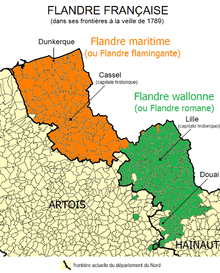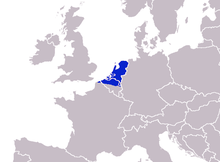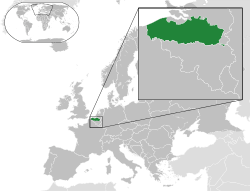French Flanders
French Flanders (French: La Flandre française; Dutch: Frans-Vlaanderen) is a part of the historical County of Flanders in present-day France. The region lies in the modern-day region of Hauts-de-France and roughly corresponds to the arrondissements of Lille, Douai and Dunkirk on the southern border of the present Kingdom of Belgium. Together with French Hainaut and the Cambrésis, it makes up the French Department of Nord.
Geography
French Flanders is mostly flat marshlands in the coal-rich area just south of the North Sea. It consists of two regions:
- French Westhoek to the northwest, lying between the Lys River and the North Sea, roughly the same area as the Arrondissement of Dunkirk;
- Walloon Flanders (French: La Flandre wallonne; Dutch: Waals Vlaanderen), to the southeast, south of the Lys River and now the Arrondissements of Lille and Douai.
History
Once a part of ancient and medieval Francia since the inception of the Frankish kingdom (descended from the Empire of Charlemagne) under the Merovingian monarchs such as Clovis I, who was crowned at Tournai, Flanders gradually fell under the control of the English and then Spanish. When French national military power returned under the Bourbons with King Louis XIV "The Sun King" (1638-1715), a part of historically French Flanders was returned to the Kingdom.
The region now called "French Flanders" was once part of the feudal state County of Flanders, then part of the Southern Netherlands. It was separated from the county (part of Habsburg's Burgundian inheritance) in 1659 due to the Peace of the Pyrenees, which ended the French-Spanish conflict in the Thirty Years War (1618-1648), and other parts of the region were added in successive treaties in 1668 and 1678. The region was ceded to the Kingdom of France, and became part of the province of Flanders and Hainaut. The bulk became part of the modern French administrative Nord departément, although some western parts of the region, which separated in 1237 and became the County of Artois before the cession to the French, are now part of Pas-de-Calais.
During World War II, 'French Flanders' referred to all of Nord-Pas de Calais, which was first attached to the military administration of German-occupied Belgium, then part of "Belgien-Nordfrankreich" under a Reichskommissar, and finally part of a theoretical Reichsgau of Flanders.
Rich in coal, facing the North Sea, bordered by usually powerful neighbors, French Flanders has been fought over numerous times in the thousand years between the Middle Ages and World War II.
Language
The traditional language of northern French Flanders (Westhoek) is a dialect of the Dutch language known as West Flemish, specifically, a subdialect known as French Flemish, spoken by around 20,000 daily speakers and 40,000 occasional users.[1] The traditional language of Walloon Flanders (part of Romance Flanders), is Picard (and its dialects, such as Ch'ti or Rouchi).
Culture
In 2008, the success of the movie Bienvenue chez les Ch'tis illuminated this part of France to a wide audience.
See also
Sources and references
- Nouveau Petit Larousse Illustré, 1952.
- French Flanders
- Ethnologue Report for West Flemish
- Flemish in France
External links
| Wikimedia Commons has media related to French Flanders. |




